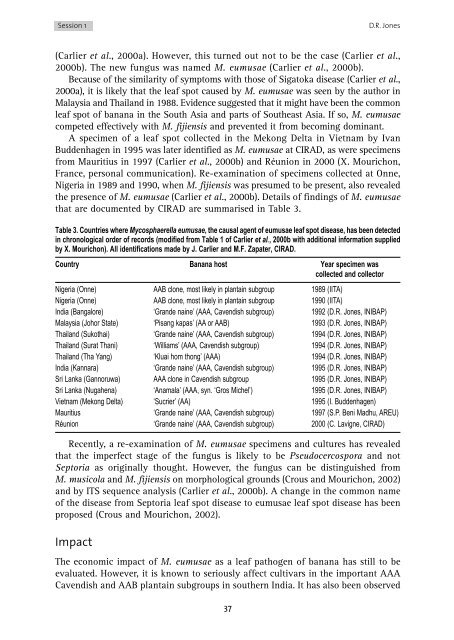Mycosphaerella leaf spot diseases of bananas - CBS
Mycosphaerella leaf spot diseases of bananas - CBS
Mycosphaerella leaf spot diseases of bananas - CBS
You also want an ePaper? Increase the reach of your titles
YUMPU automatically turns print PDFs into web optimized ePapers that Google loves.
Session 1<br />
D.R. Jones<br />
(Carlier et al., 2000a). However, this turned out not to be the case (Carlier et al.,<br />
2000b). The new fungus was named M. eumusae (Carlier et al., 2000b).<br />
Because <strong>of</strong> the similarity <strong>of</strong> symptoms with those <strong>of</strong> Sigatoka disease (Carlier et al.,<br />
2000a), it is likely that the <strong>leaf</strong> <strong>spot</strong> caused by M. eumusae was seen by the author in<br />
Malaysia and Thailand in 1988. Evidence suggested that it might have been the common<br />
<strong>leaf</strong> <strong>spot</strong> <strong>of</strong> banana in the South Asia and parts <strong>of</strong> Southeast Asia. If so, M. eumusae<br />
competed effectively with M. fijiensis and prevented it from becoming dominant.<br />
A specimen <strong>of</strong> a <strong>leaf</strong> <strong>spot</strong> collected in the Mekong Delta in Vietnam by Ivan<br />
Buddenhagen in 1995 was later identified as M. eumusae at CIRAD, as were specimens<br />
from Mauritius in 1997 (Carlier et al., 2000b) and Réunion in 2000 (X. Mourichon,<br />
France, personal communication). Re-examination <strong>of</strong> specimens collected at Onne,<br />
Nigeria in 1989 and 1990, when M. fijiensis was presumed to be present, also revealed<br />
the presence <strong>of</strong> M. eumusae (Carlier et al., 2000b). Details <strong>of</strong> findings <strong>of</strong> M. eumusae<br />
that are documented by CIRAD are summarised in Table 3.<br />
Table 3. Countries where <strong>Mycosphaerella</strong> eumusae, the causal agent <strong>of</strong> eumusae <strong>leaf</strong> <strong>spot</strong> disease, has been detected<br />
in chronological order <strong>of</strong> records (modified from Table 1 <strong>of</strong> Carlier et al., 2000b with additional information supplied<br />
by X. Mourichon). All identifications made by J. Carlier and M.F. Zapater, CIRAD.<br />
Country Banana host Year specimen was<br />
collected and collector<br />
Nigeria (Onne) AAB clone, most likely in plantain subgroup 1989 (IITA)<br />
Nigeria (Onne) AAB clone, most likely in plantain subgroup 1990 (IITA)<br />
India (Bangalore) ‘Grande naine’ (AAA, Cavendish subgroup) 1992 (D.R. Jones, INIBAP)<br />
Malaysia (Johor State) ‘Pisang kapas’ (AA or AAB) 1993 (D.R. Jones, INIBAP)<br />
Thailand (Sukothai) ‘Grande naine’ (AAA, Cavendish subgroup) 1994 (D.R. Jones, INIBAP)<br />
Thailand (Surat Thani) ‘Williams’ (AAA, Cavendish subgroup) 1994 (D.R. Jones, INIBAP)<br />
Thailand (Tha Yang) ‘Kluai hom thong’ (AAA) 1994 (D.R. Jones, INIBAP)<br />
India (Kannara) ‘Grande naine’ (AAA, Cavendish subgroup) 1995 (D.R. Jones, INIBAP)<br />
Sri Lanka (Gannoruwa) AAA clone in Cavendish subgroup 1995 (D.R. Jones, INIBAP)<br />
Sri Lanka (Nugahena) ‘Anamala’ (AAA, syn. ‘Gros Michel’) 1995 (D.R. Jones, INIBAP)<br />
Vietnam (Mekong Delta) ‘Sucrier’ (AA) 1995 (I. Buddenhagen)<br />
Mauritius ‘Grande naine’ (AAA, Cavendish subgroup) 1997 (S.P. Beni Madhu, AREU)<br />
Réunion ‘Grande naine’ (AAA, Cavendish subgroup) 2000 (C. Lavigne, CIRAD)<br />
Recently, a re-examination <strong>of</strong> M. eumusae specimens and cultures has revealed<br />
that the imperfect stage <strong>of</strong> the fungus is likely to be Pseudocercospora and not<br />
Septoria as originally thought. However, the fungus can be distinguished from<br />
M. musicola and M. fijiensis on morphological grounds (Crous and Mourichon, 2002)<br />
and by ITS sequence analysis (Carlier et al., 2000b). A change in the common name<br />
<strong>of</strong> the disease from Septoria <strong>leaf</strong> <strong>spot</strong> disease to eumusae <strong>leaf</strong> <strong>spot</strong> disease has been<br />
proposed (Crous and Mourichon, 2002).<br />
Impact<br />
The economic impact <strong>of</strong> M. eumusae as a <strong>leaf</strong> pathogen <strong>of</strong> banana has still to be<br />
evaluated. However, it is known to seriously affect cultivars in the important AAA<br />
Cavendish and AAB plantain subgroups in southern India. It has also been observed<br />
37

















